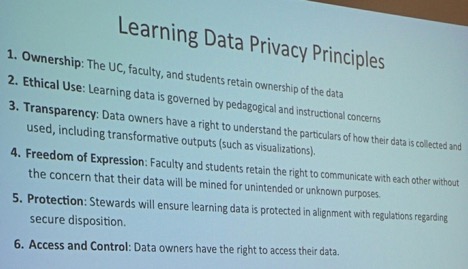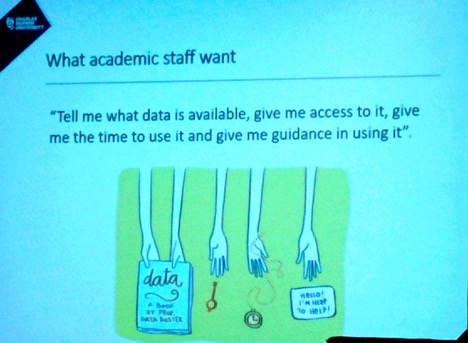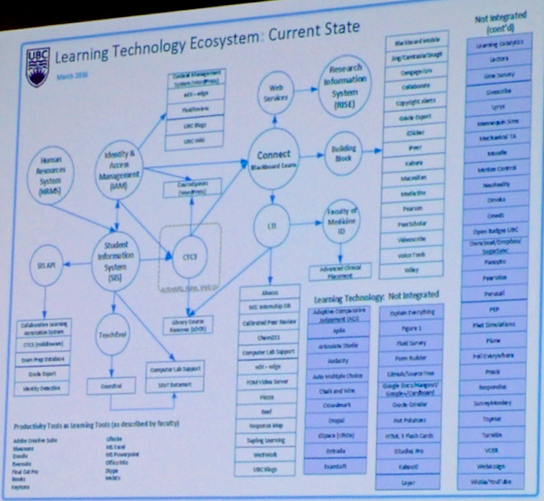EDUCAUSE is one of the largest conferences in North America focusing on post-secondary Information Technology. The 2016 edition drew over 8000 participants from around the world, representing institutional I.T. departments, teaching & learning centres, educational technologists, and product & service companies supporting post-secondary IT.
Post by Clint Lalonde, Manager, Educational Technology from the annual EDUCAUSE conference which took place October 25-28 in Anaheim, California.
I went to EDUCAUSE in the hopes of learning about two specific streams of educational technology; Next Generation Digital Learning Environments (NGDLE) and learning analytics. Both topics were well represented at the conference with dozens of presentations & panels.
Next Generation Digital Learning Environments (NGDLE)
EDUCAUSE has been a leader in helping to define the next generation of digital learning environments. In April of 2015, Malcom Brown Joanne Dehoney and Nancy Millichap released a report attempting to answer the question “what would a next generation digital learning environment look like?” The report summarized five key features of the NGDLE.
- Interoperability where tools, content and data can easily be exchanged.
- Personalization where the environment can be customized to support the needs of individuals, disciplines, and institutions.
- Analytics where learning data can be gathered and turned into actionable items.
- Collaboration, including the ability to move between both private and public spaces.
- Accessibility & universal design.
Since 2015, a number of projects have been exploring and experimenting with the concepts put forth in the paper. In the session, International Perspectives on NGDLE, Marieke de Wit (SURFNet, Netherlands), Francesc Santanach (Universitat Oberta de Catalunya, Spain) and Jeffery Merriman (MIT, USA) all spoke about how they are using emerging technical standards such as LTI and xAPI to design learning platforms and experiences that are flexible, adaptable and interoperable.
Add in a dose of Learning Analytics

A second NGDLE panel facilitated by Malcolm Brown (Leveraging Open Standards for Learning Analytics Data) dove deeper into the role of learning analytics within the NGDLE, and the important role that open data standards like Caliper and xAPI play in facilitating the interoperability of data in the learning environment. Of particular interest was the work of Jenn Stringer and UC Berkeley, who spoke of the importance of ethics with the collection and use of student data. UC Berkeley has developed 6 Learning Data Privacy Principles that underpin the work they do with learning data.
As more and more data are collected by the systems we use in higher education, having a set of principles like this is crucial to ensure that the data collected is being used ethically (see http://clintlalonde.net/2016/10/31/learning-analytics-transparency/ for more on this specific topic & session).
Learning Analytics & Scholarship of Teaching & Learning
The final session on learning analytics I attended took a slightly different view of learning analytics. Deborah West, Director of the Office of Learning & Teaching at Charles Darwin University of Australia spoke of the Australian Learning Analytics & Student Retention project, an Australian research project that looked at learning analytics through the lens of the Scholarship of Teaching and Learning and asked the question, “what do faculty want from learning analytics?” It is an important question to ask to bring the utility of learning analytics into the classroom. While these are not Deborah’s exact slides from the EDUCAUSE presentation (they are from a presentation by Deborah from anther conference), they are similar to what Deborah presented at EDUCAUSE and highlight the questions that faculty are asking to have answered by learning analytics.
All those teaching & learning apps
Another reoccurring educational technology theme at EDUCAUSE was the challenge institutions are having in vetting and supporting the sheer number of technology tools that faculty want to use.
There were numerous sessions that highlighted different evaluation and vetting processes that edtech tools go through at various institutions.
One local example of the complexity of the learning environments came from UBC when the Associate Director of Course and Learning Technologies Marianne Schroeder showed an inventory map that UBC had done of the learning tools being used at UBC. There were over 150 different technology tools being used to support teaching and learning at UBC. While several of them are connected to various institutional system, many are not, leading to complexity on both ends of the spectrum.
UBC is not alone in the challenge of vetting and supporting numerous tools being used in teaching and learning as there were numerous sessions from institutions facing the same challenge.
This is actually a good problem to have as it shows that we are moving away from the monolithic one-size fits all general purpose Learning Management System and instead focusing on smaller, more discrete tools that fit specific disciplines or pedagogical models. Hopefully, we are starting to enter a time where the tool matches the pedagogy rather than the pedagogy being forced to fit the limitations of the tools.
Keynotes: Susan Cain & Sugata Mitra
EDUCAUSE keynotes this year were from Susan Cain (Quiet: How to Harness the Strengths of Introverts to Change How We Work, Lead, and Innovate), and Sugata Mitra (The Future of Learning).
Cain is best known as the author of Quiet: The Power of Introverts in a World That Can’t Stop Talking. Her keynote focused on the often overlooked leadership qualities of introverts. As a self-described introvert, Cain’s work resonates with me, and while her keynote didn’t tread any new ground for those familiar with her previous work, to her credit Cain made the talk feel fresh and new despite fighting a lingering cold.
Cain’s keynote was in stark contrast to day 2 keynote Sugata Mitra. While Cain emphasizes the quiet power of solitude as a key ingredient for both creativity and leadership, Mitra’s work emphasizes the collaborative and collective power of the hive mind. Mitra, best know for his 1999 Hole in the Wall project, is Professor of Educational Technology at the School of Education, Communication and Language Sciences at Newcastle University and spent much of his keynote focusing on that project. Unlike Cain, who managed to make her material seem fresh and relevant, Mitra’s felt somewhat stale and dated, especially when you consider his topic was titled “The Future of Learning”. However, his message seemed to resonate with the audience, and full credit to the conference organizers for finding two keynotes with contrasting themes that complimented each other so well.
Join us at an upcoming event:
-
Facilitator Development Online (FDO) – Nov. 7 – 18, 2016
-
One-hour Pressbooks Training Webinar – Nov. 29, 2016
-
VizEd: Going Visual for Teaching & Learning – Feb. 21, 2017
-
Liberating Structures – Feb. 22 – 23, 2017
-
Facilitating Learning Online (FLO) – Mar. 20 – Apr. 21, 2017
-
Save the Date: Open Textbook Summit 2017 – May 25 – 26, 2017


